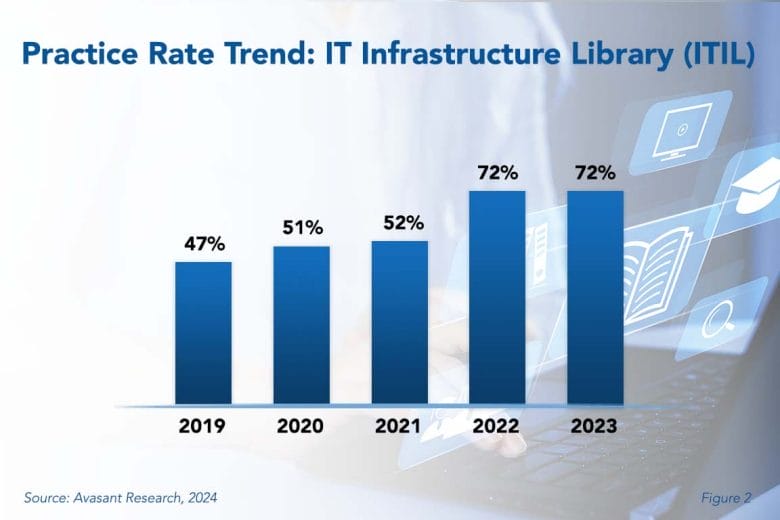Organizations have embraced ITIL to some degree. It is crucial to keep in mind, though, that following the 2022 spike, data from 2023 points to a plateau in adoption. The initial enthusiasm surrounding the adoption of ITIL 4 may have subsided because the framework’s intimidating depth and scope requires a substantial investment of time and expertise. However, ITIL is still a useful framework for businesses looking to maximize their IT service management.
As seen in Figure 2 from our full report, IT Infrastructure Library Best Practices, 72% of all organizations practice ITIL in some form. Relative to other practices in our study, the percentage of organizations that have adopted ITIL is moderate; it is not widely embraced. According to our data, adoption is unlikely to show significant growth as not many organizations reported themselves as new implementers of this best practice.

ITIL is a framework of best practices and processes designed to assist businesses in supporting, delivering, and improving their IT services. The primary goal of ITIL is to ensure that IT services align with business objectives and customer needs. Frequently adopted ITIL processes include incident management, change management, and problem management.
ITIL 4, the framework’s latest revision, ditches the rigid, process-heavy approach for a more modern, value-driven focus. This current version allows organizations to adopt a more flexible and modular strategy. They can identify the pain points and select appropriate procedures from ITIL’s extensive toolkit to directly address them.
“ITIL 4 seamlessly integrates with Agile and DevOps, fostering an environment that champions responsiveness and agility,” said Asif Cassim, principal analyst for Avasant Research, based in Los Angeles. “By combining Agile sprints, DevOps tools, and ITIL 4 processes, IT leaders can ensure rapid development, reliable service delivery, and adaptability.”
However, ITIL adoption is not without difficulties. ITIL can be complex, requiring training and expertise to understand and implement it effectively. Employees may resist changes, slowing down the implementation. Hiring consultants and finding individuals with deep ITIL expertise can be challenging. Additionally, upgrades to ITIL are something organizations will have to deal with on an ongoing basis. These updates are essential if ITIL practices are to deliver value in the long run. The costs of training, software tools, and consulting services can add up and discourage organizations from fully adopting ITIL.
Our full report begins with a brief explanation of ITIL’s history and current framework for IT service management. We next study ITIL adoption and practice levels, examining those by organization size and sector. We conclude with best practice recommendations for successful ITIL implementations.
This Research Byte is a brief overview of our report on this subject, IT Infrastructure Library Best Practices. The full report is available at no charge for subscribers, or it may be purchased by non-clients directly from our website (click for pricing).

